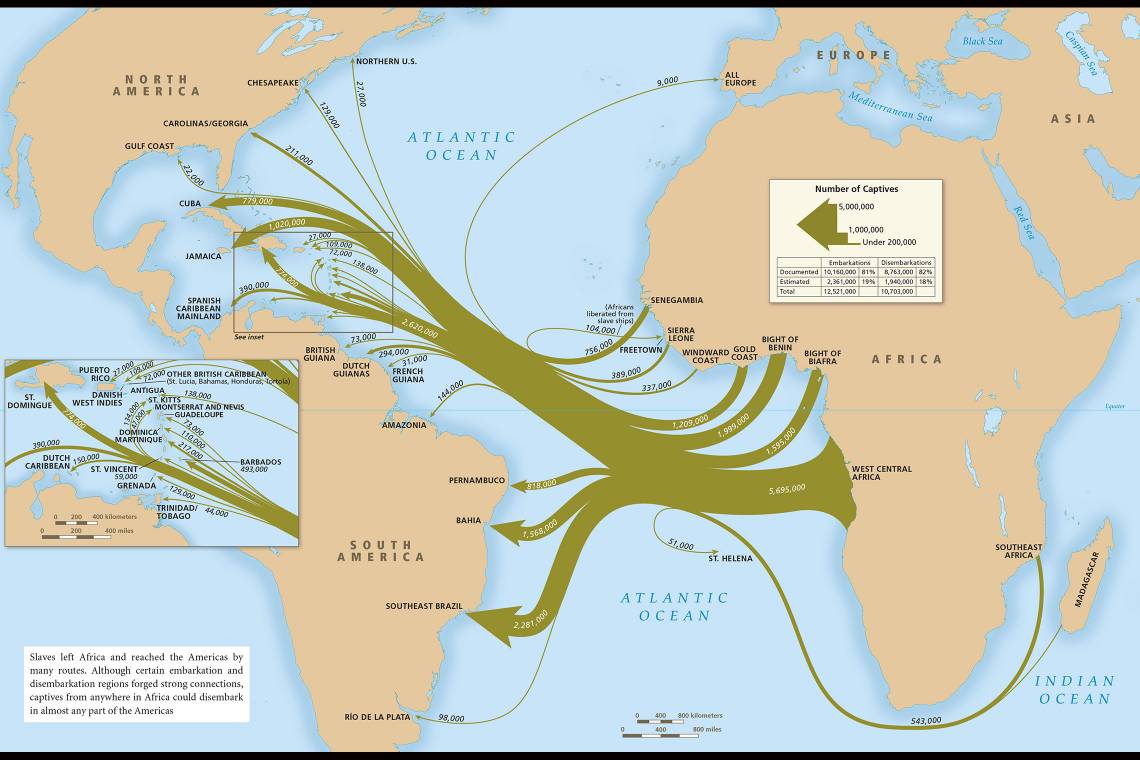
BEAUFORT, N.C. – Before deep-sea mining begins on the seafloor in international waters of the Atlantic Basin, a group of scholars is suggesting that a portion of the seabed be marked on maps and charts as a virtual memorial to the estimated 1.8 million Africans who lost their lives at sea during the trans-Atlantic slave trade and the 11 million who completed the voyage and were sold into slavery.
A memorial ribbon on maps would remind mining companies and others working on the seabed of the historical importance of the Middle Passage and the possibility that culturally significant artifacts might be found there, say the authors from Duke University, Emory University, the University of Southampton, The Ocean Foundation, and the Permanent Mission of Sierra Leone to the United Nations.
The commentary appears Nov. 3 in the Journal of Marine Policy.
"We hope that this research encourages conversation about the cultural significance of the Atlantic seabed in the context of the trans-Atlantic slave trade, and for these cultural values to be considered alongside the environmental concerns and economic interests associated with deep-sea mining," said Philip Turner, the lead author on the paper and a PhD alumnus of Duke's marine science and conservation program.
According to the group's research, more than 12.5 million Africans were carried across the Atlantic on an estimated 40,000 slave-trading voyages between 1519 and 1865. At least 1.8 million perished under horrendous conditions on the two-month voyage and were thrown overboard.
It may be possible, the authors suggest, that mining operations working a mile or more underwater will come upon artifacts of the Middle Passage, including an estimated 1,000 slave-trade shipwrecks. A wreck, if found, might contain human remains and artifacts deserving preservation like that afforded to the wreck of the RMS Titanic.
Through the United Nations Convention on the Law of the Sea (UNCLOS), nations that are members of the International Seabed Authority (ISA) have a duty to protect objects of archaeological and historical significance under Articles 149 and 303 (1) of UNCLOS. The ISA is the agency granting permits for deep-sea mining.
"The remains of the slave trade are tangible and intangible heritage that should be memorialized as the final resting place of the victims of the slave trade," said Ole Varmer, a Senior Fellow of The Ocean Foundation and retired NOAA attorney.
The draft regulations for sea-floor mining in the Atlantic put responsibility for recognizing historic sites on the mining companies, and say that if artifacts are found the companies must stop operations in the area and notify the ISA.
Around volcanically active areas of the ocean floor like the mid-Atlantic Ridge, it's common to find occurrences of copper-rich minerals. Elsewhere, crusts rich in cobalt are exposed at the surface of the seabed. Cobalt and copper are in demand for commercial uses such as electrical systems and batteries. Deep-sea mining companies are exploring for such materials from seabed environments and ultimately intend to extract the minerals with giant submersible robotic mining machines.
"We're not in any way suggesting a ban or restriction on mining, but we do want to help ensure that activities on the seabed are sensitive to the cultural heritage of the Middle Passage in the Atlantic," said co-author Cindy Van Dover, the Harvey W. Smith Distinguished Professor of Biological Oceanography in the Nicholas School of the Environment and Earth Science at Duke University.
The Middle Passage should be treated as an important site for human heritage, Turner said. "It holds a central place in the cultural memory of the slave-trade because of the staggering number of African people who came to rest on the ocean floor there," Turner said. "Maryland poet Lucille Clifton called it 'a bridge of ivory,' for all the African bones that lie between the continents."
For Sierra Leone, whose shores served as major posts for the transatlantic slave trade, "the proposal for the Middle Passage memorialization also represents an important aspect of educational outreach on the trans-Atlantic slave trade and slavery, with the solemn objective of honoring the past, celebrating the present and creating a new pathway for the future, one that is truly free and fair to all," said co-author Ambassador Michael Kanu, Deputy Permanent Representative of Sierra Leone to the United Nations.
CITATION: "Memorializing the Middle Passage on the Atlantic Seabed in Areas Beyond National Jurisdiction," Philip Turner, Sophie Cannon, Sarah DeLand, James Delgado, David Eltis, Patrick Halpin, Michael Kanu, Charlotte Sussman, Ole Varmer and Cindy Van Dover. Marine Policy, Nov. 3, 2020, DOI:10.1016/j.marpol.2020.104254
View the paper: https://doi.org/10.1016/j.marpol.2020.104254






